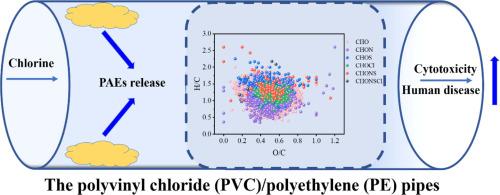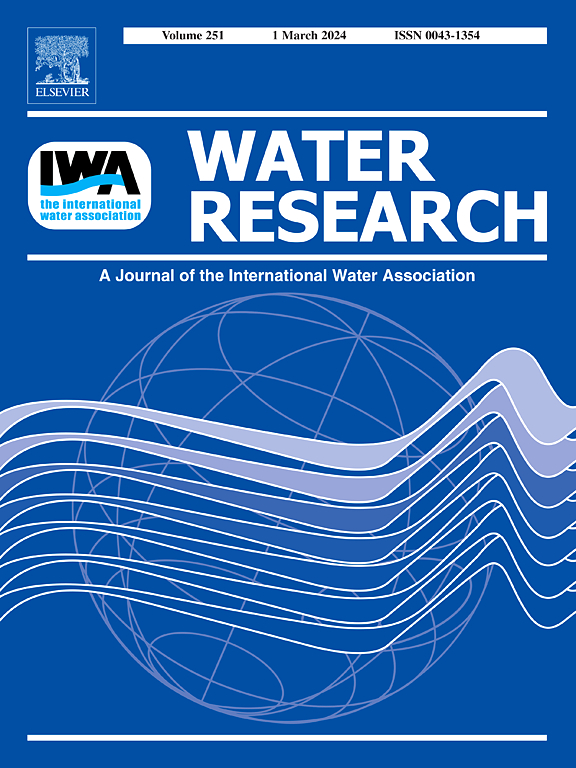Chlorination enhances the phthalates release and increases the cytotoxicity and bacterial functions related to human disease of drinking water in plastic pipes
IF 11.4
1区 环境科学与生态学
Q1 ENGINEERING, ENVIRONMENTAL
引用次数: 0
Abstract
The interaction between water and pipe surfaces can deteriorate drinking water quality, thus threatening public health. However, uncertainties remain in the release mechanism of phthalates acid esters (PAEs) from plastic pipes and their effects on drinking water quality. Our study indicated that PAEs released from polyvinyl chloride (PVC) pipes was higher than polyethylene (PE) pipes. Chlorine disinfection increased the released PAEs concentration in effluents of PE-Cl2 and PVC![]() Cl2 pipes to 6.60∼7.87 μg/L and 7.45∼8.88 μg/L, respectively. PAEs release varied the CHO and tannins numbers in dissolved organic matter (DOM), increasing the cytotoxicity of water. Although chorine disinfection reduced the abundance of pathogenic bacteria, it upregulated the relative abundance of bacterial metabolic pathways related to human disease, such as drug resistance: antimicrobial and cancer: overview. In addition, various biofilm bacterial community compositions affected the interactions between bacteria and pipe surfaces, and the roughness of pipe surfaces increased after biofilm formation. The hydrophilicity of pipe surfaces also increased due to biofilm formation and chlorine disinfection. After five months of running, higher hydrophilicity of PVC pipe surface was observed than that of PE pipes, especially after chlorine disinfection, consequently enhancing PAEs release. In conclusion, chlorine disinfection accelerated PAEs release from plastic pipes by increasing the hydrophilicity of pipe surfaces, resulting in higher cytotoxicity and microbial risk of drinking water, especially in PVC
Cl2 pipes to 6.60∼7.87 μg/L and 7.45∼8.88 μg/L, respectively. PAEs release varied the CHO and tannins numbers in dissolved organic matter (DOM), increasing the cytotoxicity of water. Although chorine disinfection reduced the abundance of pathogenic bacteria, it upregulated the relative abundance of bacterial metabolic pathways related to human disease, such as drug resistance: antimicrobial and cancer: overview. In addition, various biofilm bacterial community compositions affected the interactions between bacteria and pipe surfaces, and the roughness of pipe surfaces increased after biofilm formation. The hydrophilicity of pipe surfaces also increased due to biofilm formation and chlorine disinfection. After five months of running, higher hydrophilicity of PVC pipe surface was observed than that of PE pipes, especially after chlorine disinfection, consequently enhancing PAEs release. In conclusion, chlorine disinfection accelerated PAEs release from plastic pipes by increasing the hydrophilicity of pipe surfaces, resulting in higher cytotoxicity and microbial risk of drinking water, especially in PVC![]() Cl2 pipes. This study revealed the influence of chlorine disinfection on PAEs release and its potential risk to public health, which provided insightful visions for the future drinking water security monitoring.
Cl2 pipes. This study revealed the influence of chlorine disinfection on PAEs release and its potential risk to public health, which provided insightful visions for the future drinking water security monitoring.


求助全文
约1分钟内获得全文
求助全文
来源期刊

Water Research
环境科学-工程:环境
CiteScore
20.80
自引率
9.40%
发文量
1307
审稿时长
38 days
期刊介绍:
Water Research, along with its open access companion journal Water Research X, serves as a platform for publishing original research papers covering various aspects of the science and technology related to the anthropogenic water cycle, water quality, and its management worldwide. The audience targeted by the journal comprises biologists, chemical engineers, chemists, civil engineers, environmental engineers, limnologists, and microbiologists. The scope of the journal include:
•Treatment processes for water and wastewaters (municipal, agricultural, industrial, and on-site treatment), including resource recovery and residuals management;
•Urban hydrology including sewer systems, stormwater management, and green infrastructure;
•Drinking water treatment and distribution;
•Potable and non-potable water reuse;
•Sanitation, public health, and risk assessment;
•Anaerobic digestion, solid and hazardous waste management, including source characterization and the effects and control of leachates and gaseous emissions;
•Contaminants (chemical, microbial, anthropogenic particles such as nanoparticles or microplastics) and related water quality sensing, monitoring, fate, and assessment;
•Anthropogenic impacts on inland, tidal, coastal and urban waters, focusing on surface and ground waters, and point and non-point sources of pollution;
•Environmental restoration, linked to surface water, groundwater and groundwater remediation;
•Analysis of the interfaces between sediments and water, and between water and atmosphere, focusing specifically on anthropogenic impacts;
•Mathematical modelling, systems analysis, machine learning, and beneficial use of big data related to the anthropogenic water cycle;
•Socio-economic, policy, and regulations studies.
 求助内容:
求助内容: 应助结果提醒方式:
应助结果提醒方式:


